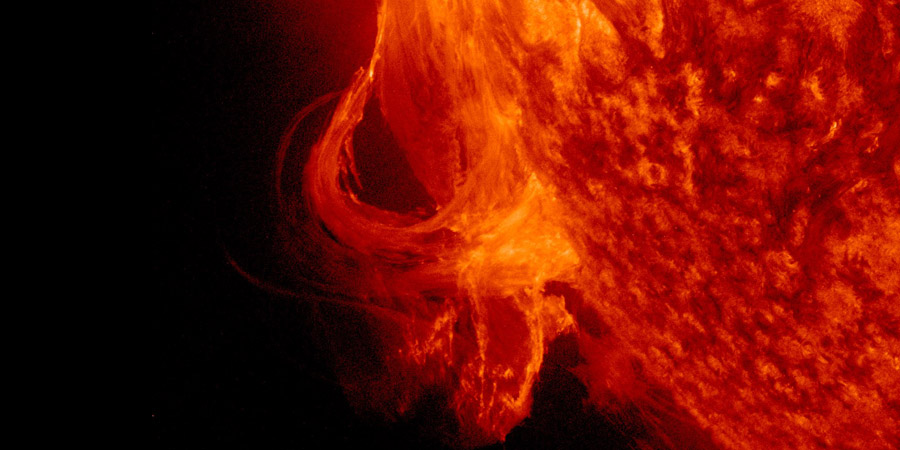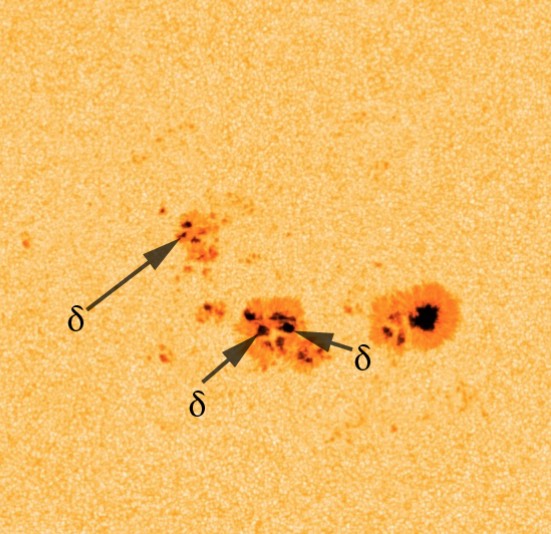Sunspot region 2205, filament eruptions
Sunday, 9 November 2014 13:18 UTC

Solar activity has been at low levels (only C-class solar flares) since the X1.6 solar flare from sunspot region 2205 that occurred 2 days ago. Sunspot region 2205 retains three delta sunspots but did shows signs of decay. There were also two eruptions this morning on the Sun that we will also take a look at.
Sunspot region 2205
Sunspot region 2205 showed minor signs of decay since our last update mainly among the trailer sunspots where it lost penumbral area and some spots. The delta sunspots remain intact but are trending away from the opposite polarity sunspots. It is still a Beta-Gamma-Delta sunspot region and complex enough for an M-class (R1-R2) event but if it continues to decay the chances will get lower.
M-class flare probability for the coming 24 hours: 50% chance
X-class flare probability for the coming 24 hours: 10% chance

All the other sunspot regions on the disk are unremarkable and unlikely to produce strong solar flares. Any future solar flares will very likely be centered around sunspot region 2205.
Filament and prominence eruptions
A filament eruption was observed this morning off the NW quadrant which occured around 09:00 UTC. Coronagraph imagery from SOHO/LASCO shows a coronal mass ejection from this event but imagery is still limited. Based on the trajactory of the ejecta as seen on SDO, we do not expect this event to have an earth-directed component.
Another gorgeous event occurred right after this filament eruption just after 10:00 UTC: a large prominence erupted on the SE limb. It will not have any effect on Earth as most of the ejecta (if not all) looked to have fallen back onto the Sun and it also didn't occur in a geo-effective position. It is however a very nice eruption to watch!
The video below shows the two eruptions. First the filament eruption in the NW quadrant followed by the prominence eruption on the SE limb.
Images and video: NASA SDO.
Thank you for reading this article! Did you have any trouble with the technical terms used in this article? Our help section is the place to be where you can find in-depth articles, a FAQ and a list with common abbreviations. Still puzzled? Just post on our forum where we will help you the best we can!
Latest news
Latest forum messages
Support SpaceWeatherLive.com!
A lot of people come to SpaceWeatherLive to follow the Sun's activity or if there is aurora to be seen, but with more traffic comes higher server costs. Consider a donation if you enjoy SpaceWeatherLive so we can keep the website online!

Space weather facts
| Last X-flare | 2025/01/04 | X1.85 |
| Last M-flare | 2025/01/22 | M1.3 |
| Last geomagnetic storm | 2025/01/04 | Kp5 (G1) |
| Spotless days | |
|---|---|
| Last spotless day | 2022/06/08 |
| Monthly mean Sunspot Number | |
|---|---|
| December 2024 | 154.5 +2 |
| January 2025 | 145.8 -8.7 |
| Last 30 days | 159.9 +39.2 |


